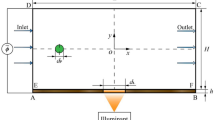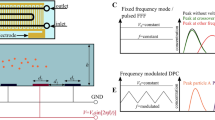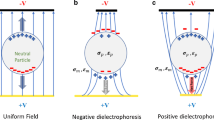Abstract
This paper presents new methods to accurately separate micro-particles with different sizes using optically induced dielectrophoretic (ODEP) forces. It is found that the strength of the ODEP force induced on the hydrogenated amorphous silicon surface is determined by the color, line-width and intensity of the optical beams, which provide an innovative design for particle separation. Two linear-segment virtual electrodes which produced the ODEP forces were firstly defined by illuminating lights onto a photoconductive chip. One moving line and one stationary illuminated line were used to generate a stronger and a weaker ODEP force, respectively. The micro-particles were then continuously pushed forward by the stronger ODEP force. As these lines approached each other, larger micro-particles entrained by the higher ODEP forces were squeezed through the stationary electrode and subsequently separated from the smaller particles. With this approach, continuous particle separation can be automatically achieved within a few seconds. This developed method may be promising for a variety of applications such as cell-based assays and sample pretreatment using micro-particles.





Similar content being viewed by others
Abbreviations
- AC:
-
Alternating current
- CCD:
-
Charge-coupled device
- CM:
-
Clausius–Mossotti
- DEP:
-
Dielectrophoretic
- DI:
-
Deionized
- DNA:
-
Deoxyribonucleic acid
- FBS:
-
Fetal bovine serum
- IPCE:
-
Incident photon-to-current conversion efficiency
- ITO:
-
Indium-tin-oxide
- LCD:
-
Liquid crystal display
- MEMS:
-
Microelectromechanical system
- ODEP:
-
Optically induced dielectrophoretic
- OET:
-
Optoelectronic tweezers
- PECVD:
-
Plasma enhanced chemical vapor deposition
- E :
-
Electric field strength
- r :
-
Radius of the spherical particle
- v :
-
Terminal velocity of the spherical beads
- ε m :
-
Electrical permittivity of the surrounding buffer
- η :
-
Dynamic viscosity of the fluid
References
Berger M, Castelino J, Huang R, Shah M, Austin RH (2001) Design of a microfabricated magnetic cell separator. Electrophoresis 22:3883–3892
Calmettes PP, Berns MW (1983) Laser induced multiphoton processes in living cells. Proc Natl Acad Sci USA 80:7197–7199
Carlson DE (1980) Recent developments in amorphous silicon solar cells. Solar Energy Mater 3:503–518
Carlson DE, Wronski CR (1976) Amorphous silicon solar cell. Appl Phys Lett 28:671–673
Chapman CF, Liu Y, Sonek GJ, Tromberg BJ (1995) The use of exogenous fluorescent probes for temperature measurements in single living cells. Photochem Photobiol 62:416–425
Chiou PY, Chang Z, Wu MC (2003) A novel optoelectronic tweezer using light induced dielectrophoresis. In: Proceedings of the international conference on optical MEMS. IEEE/LEOS, Waikoloa
Chiou PY, Ohta AT, Wu MC (2005a) Optical sorting mechanism in dynamic electric field induced by optoelectronic tweezers. In: Proceedings of the international conference on bio-nano-informatics fusion. BNI, Anaheim
Chiou PY, Ohta AT, Wu MC (2005b) Massively parallel manipulation of single cells and microparticles using optical images. Nature 436:370–372
Choi S, Park JK (2005) Microfluidic system for dielectrophoretic separation based on a trapezoidal electrode array. Lab Chip 5:1161–1167
Choi JM, Ahn CH, Bhansali S, Henderson HT (2000) A new magnetic bead-based, filterless bio-separator with planar electromagnet surfaces for integrated bio-detection systems. Sens Actuators B Chem 68:34–39
Choi S, Song S, Choi C, Park JK (2007) Continuous blood cell separation by hydrophoretic filtration. Lab Chip 7:1532–1538
Choi W, Nam SW, Hwang H, Park S, Park JK (2008) Programmable manipulation of motile cells in optoelectronic tweezers using a grayscale image. Appl Phys Lett 93:143901–143903
Connell GAN, Pawlik JR (1976) Use of hydrogenation in structural and electronic studies of gap states in amorphous germanium. Phys Rev B 13:787–804
Curtis JE, Koss BA, Grier DG (2002) Dynamic holographic optical tweezers. Opt Commun 207:169–175
De mello AJ, Beard N (2003) Dealing with ‘real’ samples: sample pre-treatment in microfluidic systems. Lab Chip 3:11N–19N
Doh I, Cho YH (2005) A continuous cell separation chip using hydrodynamic dielectrophoresis (DEP) process. Sens Actuators A Phys 121:59–65
Fuchs AB et al (2006) Electronic sorting and recovery of single live cells from microlitre sized samples. Lab Chip 6:121–126
Gascoyne P, Satayavivad J, Ruchirawat M (2004) Microfluidic approaches to malaria detection. Acta Trop 89:357–369
Grier DG (2003) A revolution in optical manipulation. Nature 42:810–816
Hughes MP (2002) Strategies for dielectrophoretic separation in laboratory-on-a-chip systems. Electrophor Rev 23:2569–2582
Iliescu C, Xu GL, Ong PL, Leck KJ (2007) Dielectrophoretic separation of biological samples in a 3D filtering chip. J Micromech Microeng 17:S128–S136
Jager EWH, Inganas O, Lundstrom I (2000) Microrobots for micrometer-size objects in aqueous media: potential tools for single-cell manipulation. Science 288:2335–2338
Jamshidi et al (2008) Dynamic manipulation and separation of individual semiconducting and metallic nanowires. Nat Photonics 2:86–89
Kang Y, Li D, Kalams SA, Eid JE (2008) DC-Dielectrophoretic separation of biological cells by size. Biomed Microdevices 10:243–249
Lien KY, Lin WY, Lee YF, Wang CH, Lei HY, Lee GB (2008) Microfluidic systems integrated with a sample pretreatment device for fast nucleic-acid amplification. J Microelectromech Syst 17:288–301
Liu Y, Sonek GJ, Berns MW, Tromberg BJ (1996) Physiological monitoring of optically trapped cells: assessing the effects of confinement by 1064-nm laser tweezers using microfluorometry. Biophys J 71:2158–2167
Liu SD, Lee SC, Chern MY (2001) Hydrogenated amorphous silicon–germanium PIN X-ray detector. IEEE Trans Electron Devices 48:1564–1567
Loveland RJ, Spear WE, Al-Sharboty A (1973) Photoconductivity and absorption in amorphous Si. J Noncryst Solids 13:55–68
MacDonald MP, Spalding GC, Dholakia K (2003) Microfluidic sorting in an optical lattice. Nature 426:421–424
Maranesi N, Romani A, Medoro G, Altomare L, Leonardi A, Tartagni M, Guerrieri R (2004) A CMOS chip for individual cell manipulation and detection. J Solid State Circuits 38:2297–2305
Markx GH, Talary MS, Pethig R (1994) Separation of viable and non-viable yeast using dielectrophoresis. J Biotechnol 32:29–37
Miltenyi S, Müller W, Weichel W, Radbruch A (1990) High gradient magnetic cell separation with MACS. Cytometry 11(2):231–238
Neuman KC, Chadd EH, Liou GF, Bergman K, Block SM (1999) Characterization of photodamage to Escherichia coli in optical traps. Biophys J 77:2856–2863
Ohta AT, Chiou PY, Phan HL, Sherwood SW, Yang JM, Lau ANK, Hsu HY, Jamshidi A, Wu MC (2007a) Optically controlled cell discrimination and trapping using optoelectronic tweezers. IEEE J Sel Top Quantum Electron 13:235–243
Ohta AT, Chiou PY, Han TH, Liao JC, McCabe ERB, Yu F, Sun R, Wu MC (2007b) Dynamic cell and microparticle control via optoelectronic tweezers. J Microelectromech Syst 16:491–499
Pohl HA (1978) Dielectrophoresis. Cambridge University Press, Cambridge
Street RA (1991) Hydrogenated amorphous silicon. Cambridge University Press, New York
Stutzmann M, Jackson WB, Tsai CC (1985) Light-induced metastable defects in hydrogenated amorphous silicon: a systematic study. Phys Rev B Condens Matter 32:23–47
Urdaneta M, Smela E (2008) The design of dielectrophoretic flow-through sorters using a figure of merit. J Micromech Microeng 18:015001–015009
Voldman J (2006) Electrical forces for microscale cell manipulation. Annu Rev Biomed Eng 8:425–454
Vulto P, Medoro G, Altomare L, Urban GA, Tartagni M, Guerrieri R, Manaresi N (2006) Selective sample recovery of DEP-separated cells and particles by phaseguide-controlled laminar flow. J Micromech Microeng 16:1847–1853
Wang MM, Tu E, Raymond DE, Yang JM, Zhang H, Hagen N, Dees B, Mercer EM, Forster AH, Kariv I, Marchand PJ, Butler WF (2004) Microfluidic sorting of mammalian cells by optical force switching. Nat Biotechnol 23:83–87
Wei JH, Lee SC (1993) Electrical and optical properties of implanted amorphous silicon. J Appl Phys 76:1033–1040
Yamada M, Tsud KKY, Kobayashi J, Yamato M, Seki M, Okano T (2007) Microfluidic devices for size-dependent separation of liver cells. Biomed Microdevices 9:637–645
Zhang X, Cooper JM, Monaghanb PB, Haswell SJ (2006) Continuous flow separation of particles within an asymmetric microfluidic device. Lab Chip 6:561–566
Acknowledgments
The authors would like to thank Chi-Mei Optoelectronics Inc. for their financial support from grant number (96S036). Partial financial support provided to this study by the National Science Council of Taiwan is also greatly appreciated. Authors also thank Dr T.F. Guo for valuable discussion.
Author information
Authors and Affiliations
Corresponding author
Additional information
Preliminary data of the study has been published in Proceedings of IEEE MEMS 2009, Sorrento, Italy.
Rights and permissions
About this article
Cite this article
Lin, WY., Lin, YH. & Lee, GB. Separation of micro-particles utilizing spatial difference of optically induced dielectrophoretic forces. Microfluid Nanofluid 8, 217–229 (2010). https://doi.org/10.1007/s10404-009-0457-y
Received:
Accepted:
Published:
Issue Date:
DOI: https://doi.org/10.1007/s10404-009-0457-y




